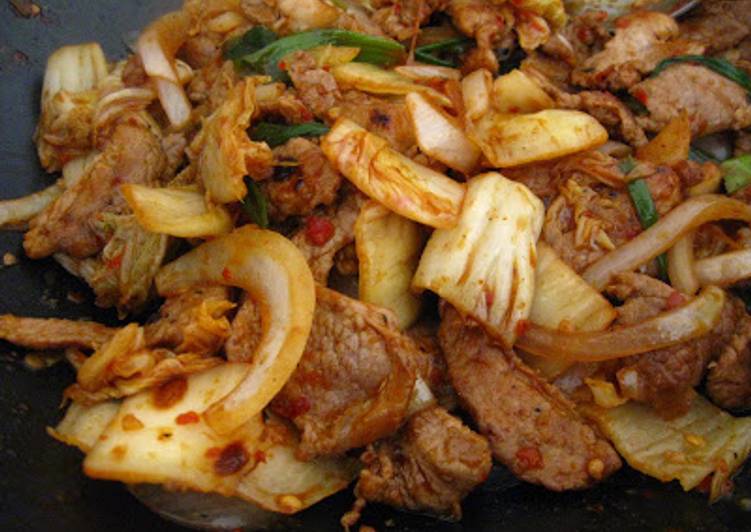Kimchi Bokkeum (Kimchi Stirfry). Heat the vegetable oil in a skillet over medium high heat. Stir fry the meat in two equal batches, adding oil to the second batch, until the meat is cooked through and browned on both sides. Because these slices of pork are a little big for regular stir fry, you may want to let them sit on the cooking surface for a minute or so to give them a nice sear before you start stirring.
 You take one bite, and immediately need another bite. Super savory, meaty, juicy, and delicious with some rice. It has the spices and tanginess from the kimchi, the fat and savory taste from the pork belly, and just the right amount of seasoning. Add the onion and scallion and stir-fry quickly over high heat. You can cook Kimchi Bokkeum (Kimchi Stirfry) using 13 ingredients and 7 steps. Here is how you achieve that.
You take one bite, and immediately need another bite. Super savory, meaty, juicy, and delicious with some rice. It has the spices and tanginess from the kimchi, the fat and savory taste from the pork belly, and just the right amount of seasoning. Add the onion and scallion and stir-fry quickly over high heat. You can cook Kimchi Bokkeum (Kimchi Stirfry) using 13 ingredients and 7 steps. Here is how you achieve that.
Ingredients of Kimchi Bokkeum (Kimchi Stirfry)
- Prepare of pork shoulder or belly meat, sliced into roughly 1/4"thick, 1" x 2" pieces.
- It's of kosher salt.
- Prepare of ripe kimchi with the excess liquid squeezed out (reserve 1 Tablespoon of the liquid for seasoning) By *ripe*, I mean at least as sour as a kosher dill.
- Prepare of sliced onion (about 1/2 medium).
- You need of green onions, sliced into 2 inch segments.
- It's of gochujang (Korean red chili paste).
- Prepare of soy sauce.
- You need of minced garlic (about 1 small clove).
- It's of to 1 Tablespoon sugar (depending on how sweet you like your food).
- Prepare of kimchi liquid.
- Prepare of neutral oil.
- You need of butter (optional).
- It's of optional toasted sesame oil.
Add the kimchi, optional carrots, juice from kimchi, soy sauce and gochujang. Take the time to do this step so the rich flavors develop. I guarantee you won't be able to stop eating! When the pork has browned on one side, flip them over and brown the other side.
Kimchi Bokkeum (Kimchi Stirfry) step by step
- Season the pork with the salt. I purposely add only a little salt to the meat because the kimchi is pretty darned salty, as we all know..
- In a large wok or skillet, heat about 2 teaspoonfuls of oil over medium high to high heat and wait until it's so hot that it starts to smoke. If you look closely, you can somewhat sorta see that the oil's so hot it's rippling..
- Stir fry the meat in two equal batches, adding oil to the second batch, until the meat is cooked through and browned on both sides. Because these slices of pork are a little big for regular stir fry, you may want to let them sit on the cooking surface for a minute or so to give them a nice sear before you start stirring. Set aside the cooked pork..
- Now add 2 Tablespoons of oil to the wok or skillet and let it heat up again before adding the onions, green onions and kimchi. Keep the heat on high as you stir fry these components until the onions start to become translucent..
- Once the onions are translucent, remove the wok from the heat and make a well in the center where you'll add 1 Tablespoon of oil and, if you like, a half Tablespoon of butter..
- Put all the seasoning components into the well and return the wok to the heat. Stir to incorporate all the seasoning ingredients and wait until you see the gochujang bubbling a bit - this is when the sugars start to caramelize..
- When the seasoning sauce has been bubbling for 20 to 30 seconds, stir in the veg and then the cooked pork along with whatever juices come with it. Add in 1 to 2 teaspoons of toasted sesame oil for flavor at this point if you like. Give it a few good stirs to make sure all the flavors are evenly distributed, and there ya have it - kimchi bokkeum..
Add the squeezed kimchi and stir-fry until the kimchi starts to brown. Give the kimchi juice another stir and then add it to the pan along with the garlic chives. Flavorful strips of pork shoulder are marinated in a spicy-sweet sauce, then stir-fried with kimchi. Jayook bokum also known as jaeyook kimchi bokum, is a delicious Korean dish that consists of marinated pork loin which are stir-fried with kimchi and red chili pepper paste, gochujang. When making jaeyook bokum, gochujang is the key base sauce to this dish which determines the flavor and its level of spiciness.
Comments
Post a Comment